Franchise Rewind: Back to the Future, (1985) Back to the Future, Part II (1989) Back to the Future, Part III (1990)
Back to the Future, 1985 (Michael J. Fox) MCA/Universal
Back to the Future, Part II, 1989 (Michael J. Fox) MCA/Universal
Back to the Future, Part III, 1990 (Michael J. Fox) MCA/Universal
“Last night, Darth Vader came down from Planet Vulcan and told me that if I didn’t take Lorraine out, that he’d melt my brain.”
In the land of the motion picture franchise, Back to the Future is an astonishing example of restraint. Three quality films (starting with this one) were released between 1985 and 1990. The two sequels were shot back-to-back in 1989, meaning that although the movie was enormously profitable (close to $400 million on a $20 million budget), and the studio was most definitely clamoring for follow-ups, director Robert Zemeckis, co-writer Bob Gale, and “golden child” Steven Spielberg took their time about it. They might’ve waited too long, but we’ll get into that when we get into that.
Back to the Future is an intriguing example of a kid’s movie with a dirty mind. It’s all built on the idea of Marty McFly’s (Michael J. Fox) parents having sex. That’s really all it comes down to, because if they don’t, Marty McFly ceases to exist. I know what you’re thinking. Who cares if Marty McFly ceases to exist? I mean, after two more movies, it seems like Marty causes more problems than he solves because of his existence. The premise is insane, but is dripping with “cool.” Marty’s friend, the scatterbrained Doc Brown (Christopher Lloyd), has constructed a time machine out of a DeLorean with plutonium stolen from Libyan terrorists.
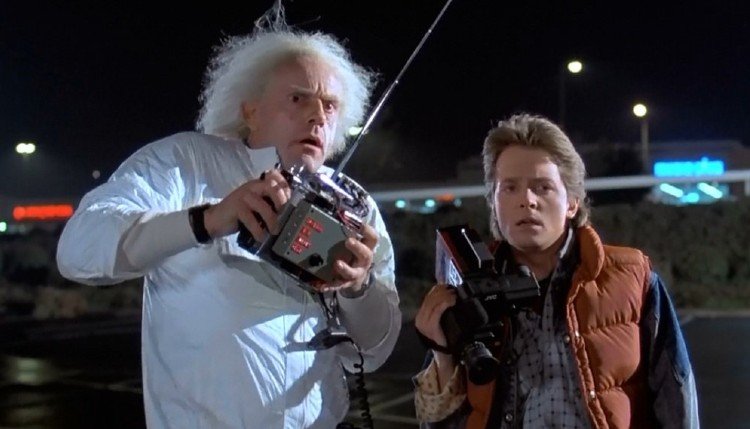
He has Marty videotape his demonstration, but the Libyans show up after they realize he conned them out of their plutonium. The Libyans kill Brown and Marty takes off in the car, which hits 88 miles-per-hour, activating the time machine portion of the vehicle. Marty goes back in time to November of 1955, coincidentally the week his parents met. He catches his future father, George McFly (Crispin Glover) spying on his future mother, Lorraine (Lea Thompson) from a tree across the street. He falls from the tree and Marty pushes him out the way of an oncoming car.
Marty is struck by the car instead and is brought back to Lorraine’s house, and as such, she finds herself immediately attracted to him. Uh. Wow. There’s a whole load of implications associated with this development, but the script skips over those Freudian bumps. Marty, with the help of Doc Brown from the past, deduces that George was supposed to have been hit by the car and nursed back to health by Lorraine, but Marty screwed the whole thing up! Lorraine falls for her son in a big way. Uh. Okay.
This does set up an excellent conflict for Marty as he must figure out a way to get these two crazy kids together so that he isn’t catapulted into a black hole of non-existence. He also has to deal with local bully, Bif Tannen (Thomas F. Wilson) who keeps hounding George and making unwanted advances on Lorraine. In addition, because plutonium isn’t all that readily available in 1955, Doc Brown surmises he could get an equivalent force of power from a lightning strike.
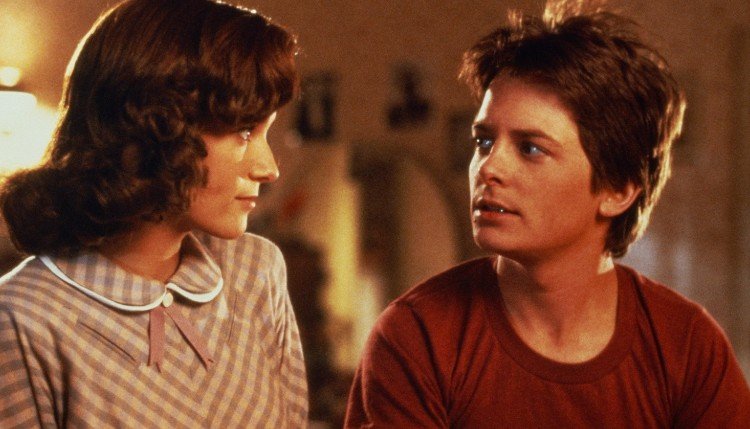
This is an exceptionally clever movie that made a huge star out of Fox, but I do take issue with the ending. Marty doesn’t restore the past and his history. He actually improves it by changing certain motivations. His father, as initially revealed, is a well-meaning, docile man who works for Bif in the present. Because of Marty’s changes to the timeline, George becomes a confident best-selling science fiction author (this is definitely a fantasy). He and his family still live in the same house, but it’s a lot more spruced up. Marty has a Toyota pick-up truck, and Bif is the family’s bitch.
Crispin Glover seemed to have the same problem with the resolution of the story. In a podcast interview with IGN, he spoke about his concerns with regard to the relative materialistic ending, which gives the McFly family happiness through financial prosperity. The film also assumes that confidence obtained in the past (or in a person’s youth) will evidently continue and grow stronger in the future. I don’t know if that’s true either. Despite this Fun with Dick & Jane approach to quantum mechanics and self-help, Back to the Future is a fun, clever mix of science fiction and comedy.
“Shark still looks fake.”
I think Back to the Future Part II might’ve missed the boat being released four years after the original hit movie. This was part of the sequel mentality, particularly as it began to blossom in 1989. There were more recent movies (such as Lethal Weapon and Friday the 13th Part VII: The New Blood) that were fresh in the public consciousness, but some sequels (like Ghostbusters II) were late to the game. I don’t think Indiana Jones counts because the character was much more of a cultural icon and touchstone than Marty McFly.
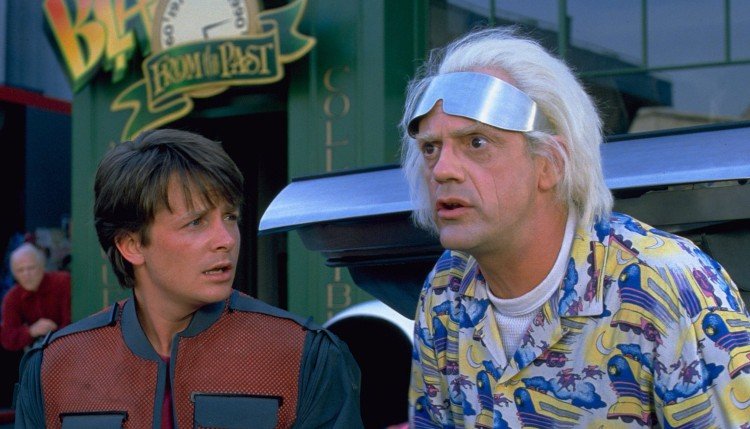
You can’t drop Marty into an adventure and expect him to hold his own (or somebody else’s—poom!). The first Back to the Future movie felt like a cute, one-off fantasy; a classic ’80s movie, even as Doc Brown tells Marty at the end of the movie that they have to fix the future because of his idiot children. Doc Brown should, oh, I don’t know, leave well enough alone and stop tampering with timelines, for crying out loud, but if he did, we wouldn’t have a sequel, so there. This sequel is a mess, but it’s a well-made, cutesy-clever mess.
“How ’bout a ride, Mister,” Elisabeth Shue seductively asks Marty as he marvels over his brand new Toyota pickup truck and OH MY GOD…er, WAIT A MINUTE! What? Elisabeth Shue? What happened to the other chick? I mean, it’s the same shot, okay, Michael J. Fox looks a little chubbier and somebody let out his suspenders, and she’s got the right hair and clothes, but it’s not Jennifer! It’s clones! Now why didn’t they make that a plot point? What happened to the real Jennifer? Now that I think of it, what happened to Elisabeth Shue at the end of The Karate Kid?
There’s a massive conspiracy going on. I’m sure of it. Must have something to do with 5G. We go into the same ending of Back to the Future, the same dialogue, the same costumes, the same camera angles but this time Claudia Wells has been replaced by Elisabeth Shue. Doc Brown (Christopher Lloyd) takes Marty McFly (Michael J. Fox) and his girlfriend, Jennifer (not Claudia Wells) into the future with his fancy-pants flyin’ DeLorean that runs on garbage. Apparently, there’s some kind of a problem with their kids. As if!
We’re supposed to assume that skittish, short-attention-span Marty with his skateboard is able to hold onto this girl well into adulthood? And then to get married and produce little McLarvae? I don’t believe it. I mean, I know it’s a movie about time travel, but … moving on. They go 30 years into the future, oh! I forgot to mention that this movie also employs the trick of time-traveling within movie time, just like Rocky and The Karate Kid.
1985 lasts four years, since we begin the movie at the end of the previous movie, so we can add Michael J. Fox to the list of actors who visibly age in a relatively short period of time, along with Ralph Macchio and Sylvester Stallone. Keeping track of this can make you a little crazy after a while. I suspect the sequel was less a logical progression of the Marty’s story than it was a conglomeration of goofy ideas about the future, such as self-tying Nikes (those are cool, by the way—I’m a big fan of Nike hi-tops), jackets that adjust to any size (convenient), all teenagers wearing their pants inside out (ridiculous), and piles of laserdiscs dumped into the garbage (prophetic).
Doc Brown’s entire gambit hinges on the idea that McFly’s kid, Marty Jr., will help Bif’s grandson (imaginatively named Griff), with a robbery. I think Doc Brown should mind his own business. There’s an insulting cookie-cutter logic to the whole affair that assumes that if you tell somebody not to do something, or you refuse to do something, somehow it will do wonders for your character. In this case, it’s much worse as Marty is asked to impersonate his son and then refuse to participate in the robbery. We could try to help the young man or try to understand why he’s become a deviant, but no—the band-aid looks better.
The movie becomes enormously confusing as Marty travels between 2015, 1973, 1985, and 1955—all of this due to Bif figuring out the time travel and purchasing an almanac which he intends to give to his younger self in 1955 and make him a multi-millionaire in the future. Materialism seems to be the good guy and the bad guy of these movies, and people are powerless little cogs in their own lives driven to make money and own things because they’re convinced this is the only way they can be happy.
All of this was playing out against the backdrop of recession in the late ’80s/early ’90s when people were losing their fortunes overnight. The dream of the ’80s was dead. Marty continues to effect changes in his own timeline, in 1955, and in the original movie, but this time, the freak lightning bolt sends Doc Brown to 1885, while his 1955 “variant” remains and promptly faints upon seeing Marty again.
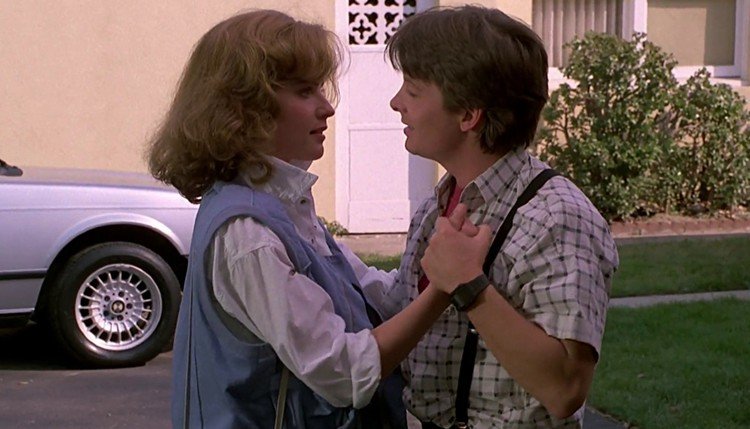
I know this sequel is seen as a “classic” these days (likely due to the eerie prediction that in 2015 the Cubs will have won the World Series—they didn’t but they did make the Championship, which they lost to my Mets), but critics and audiences were less kind when it was released in 1989. Kids enjoyed the “product placement future”, and Blade Runner cars, but critics were baffled by the “wibbly-wobbly timey-wimey” narrative. The next movie, Back to the Future, Part III (a direct continuation of the story) would aim to please crowds with a linear story rather than bombard them with near-constant pop culture references and visual effects.
“Marty, the future isn’t written. It can be changed. You know that. Anyone can make their future whatever they want it to be. I can’t let this one little photograph determine my entire destiny. I have to live my life according to what I believe is right in my heart.”
A time travel movie without Mary Steenburgen in the cast is like a day without sunshine. The two go together so well … so well. I’m not being flippant. Time After Time is one of my favorite movies ever. It’s a beautiful, historically anachronistic romance that spans time and space. Back to the Future, Part III reverses the roles however; where Steenburgen was a progressive contemporary feminist in Time After Time, here she plays Clara Clayton, kindly teacher (read: spinster) in 1885 Hill Valley—the “Old West.”
She represents an “Edith Keeler” paradox for Doc Brown who, somewhat accidentally, rescued her from falling into a ravine and dying, thus changing a possible timeline. Fortunately, we don’t get into the “let’s kill Hitler” hysterics of Harlan Ellison. Robert Zemeckis (with his frequent collaborator Bob Gale) wants to craft a harmless love odyssey; something to make the audience feel good after the Rube Goldberg-esque terror trap of time travel and product placement from the previous movie (though we do get Nike cowboy boots—shameless).
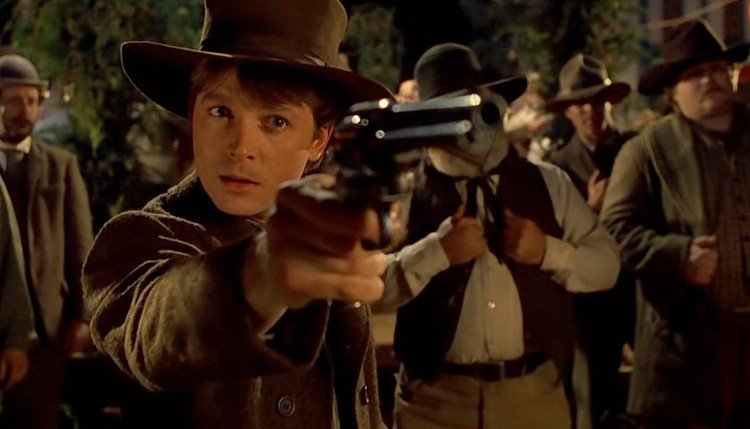
When we last left off, Marty was trapped back in 1955 after correcting three separate timelines. Doc Brown (Christopher Lloyd) passed out. Marty brings him back to his house, and now they must get Marty to 1885 to rescue Doc Brown in that timeline’s past. The reason for this rescue is because Marty saw a photo of a tombstone inscription stating Brown was killed by “Mad Dog” Tannen (Biff’s great-grandfather, also played by F. Thomas Wilson).
It only now occurs to me the Tannen genealogy exists to provide a nemesis for each McFly in the respective McFly genealogy, like a kind of Moriarty to Sherlock Holmes, anti-matter to matter, Magneto to Xavier, Khan to Kirk, Joker to Batman, Luthor to Superman, Odie to Garfield, etc. At this point, I would begin to suspect I was God’s play-thing, like Job—just a toy to be abused at the pleasure of the Universe for no reason. Because Brown falls in love with Clara, regardless of his impending murder, he wants to stay in the past with her, which is sweet. It’s nice.
I like that Brown is willing to sacrifice his future to be with the woman he loves. It’s a reckless (yet mature) plot twist from Gale and Zemeckis this time around. However, to know that this is the end of the story leaves much to be desired. It places the trilogy within the context of the character of Doc Brown. The point of the trilogy was not Marty McFly’s (or his family’s) happiness and well-being. The point of the trilogy was for Doc Brown to find true love, and that doesn’t mesh well with plutonium, Libyan terrorists, Goldie Wilson, Pepsi Free, or even time travel.
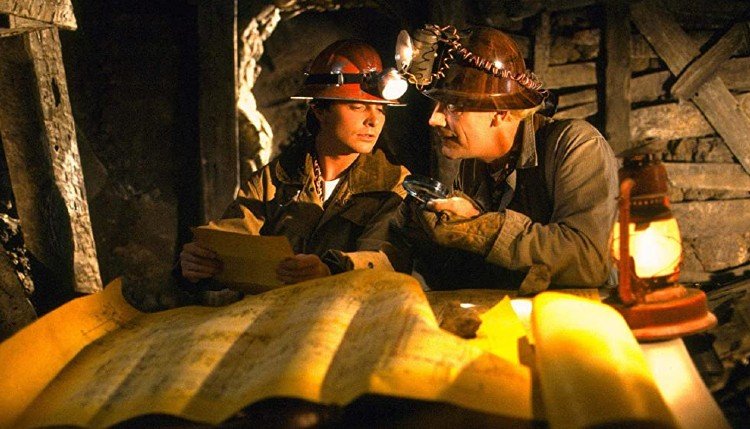
This wasn’t an intensely satisfying conclusion to the Back to the Future trilogy—it made nearly a hundred million dollars less than the previous movie, even though it was superior in terms of the storytelling. I think audiences were turned off at the idea of a goofy Western. Westerns were dead by that point. It was only when Clint Eastwood made Unforgiven that Westerns became hot again. Some of the visual effects, particularly the doubling-up of McFlys in the same shot, are embarrassingly bad (considering the same team would make Forrest Gump four years later).
Zemeckis is a decent filmmaker (Romancing the Stone is a personal favorite of mine), but he cuts corners in ways Joe Dante or John Landis would never dare. He would go on to make the most overrated movie in the universe, Forrest Gump, as well as some good movies like Cast Away and What Lies Beneath. Recently, he made an unnecessary remake of Nic Roeg’s The Witches, and an unnecessary live-action remake of Pinocchio.

